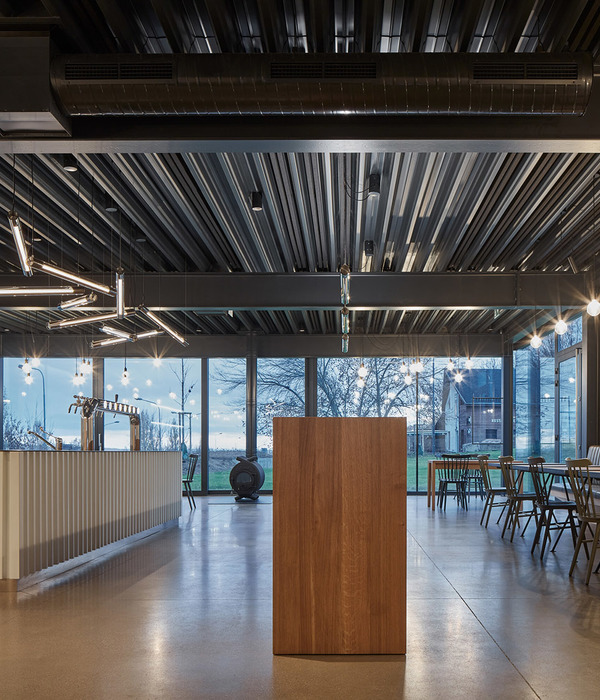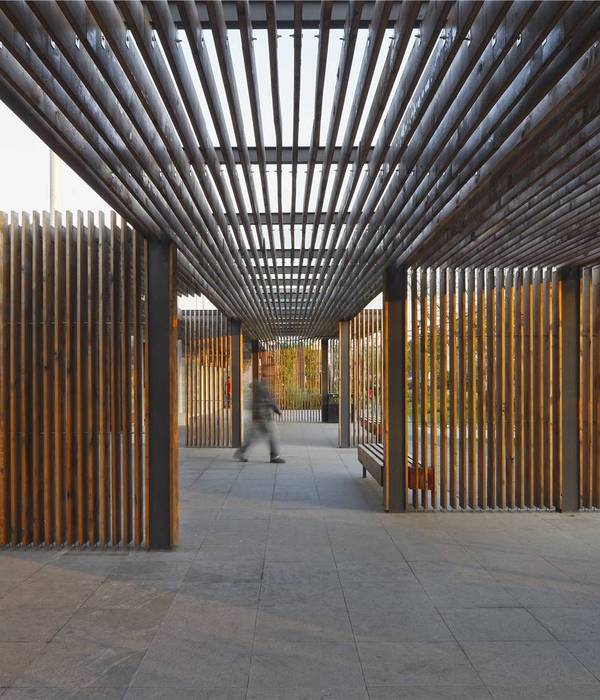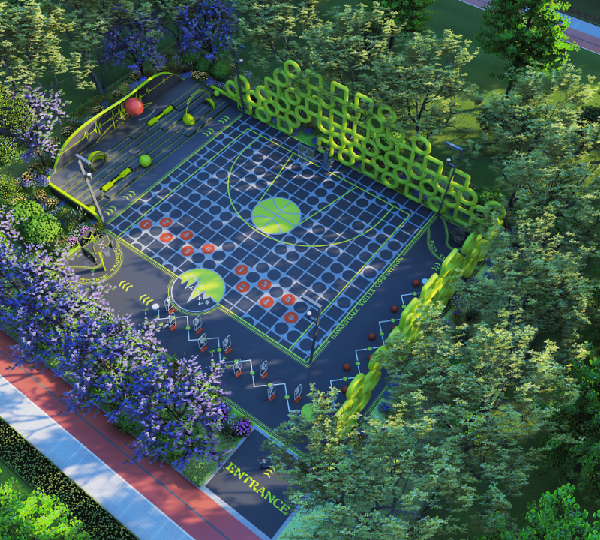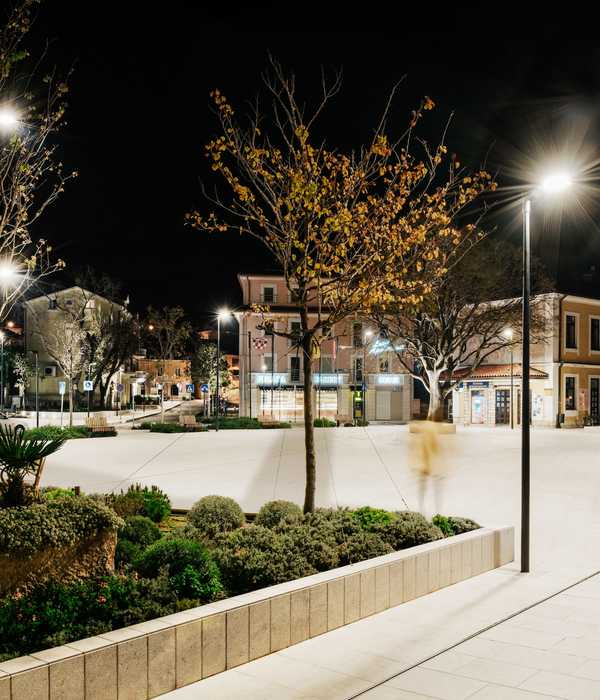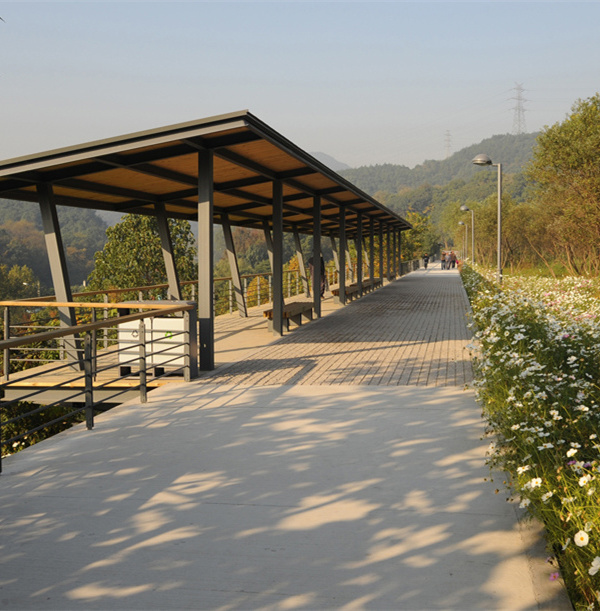项目陈述 Project Statement
北卡罗来纳州的波洛克斯维尔镇(人口仅216)仍然处在佛罗伦萨飓风(2018)的灾后恢复过程之中。这次飓风产生的降雨量堪称千年一遇,给北卡罗来纳州造成了170亿美元的损失。在波洛克斯维尔,风暴带来的冲击远远超过了500年一遇的洪水承受力,它淹没了数十户家庭和该镇近三分之二的商业财产。波洛克斯维尔社区防洪计划通过一个综合性的项目群组来支持当地的恢复工作,每个项目都是通过参与性的设计过程和严格的分析,由团队与社区共同完成。最终的成果将协助当地领导人为波洛克斯维尔建立更强的抵御未来冲击的能力。
该项目植根于地方的社区规划和发展、减灾计划以及气候适应方法。该计划认识到了当地的财政现状、多代人的社会网络、个人对地方的依恋和因地制宜的微型迁徙策略,这些都是在低收入乡村地区的恢复过程中所必须考虑的方面。该镇下发的文件阐述了波洛克斯维尔努力重建的过程,并为其他受到较大环境威胁且资源不足的社区提供了可以挪用的经验。
Pollocksville, North Carolina (population 216) is in the midst of a multi-year recovery process resulting from Hurricane Florence (2018). The rainfall generated by Florence was equivalent to a 1,000-year storm event, causing $17B in damages in North Carolina. In Pollocksville, the storm’s flooding impacts far exceeded the 500-year floodplain, inundating dozens of homes and nearly two-thirds of the town’s commercial properties. The Pollocksville Community Floodprint bolstered local recovery efforts through an integrated portfolio of projects that were co-produced with the community via participatory processes and rigorous analysis. Outcomes are assisting local leaders make Pollocksville more resilient to future shocks.
The project was rooted in place-based approaches to community planning and development, hazard mitigation, and climate adaptation. The plan recognizes the financial realities, multi-generational social networks, personal place attachments, and bespoke micro-migration strategies that must be considered in the recovery processes of low-wealth rural areas. The resulting town-adopted document illustrates processes that both respond to Pollocksville’s efforts to build back better and provide transferable lessons to other under-resourced communities that are disproportionately impacted by environmental threats.
▲社区洪水足迹:“洪水足迹”是一个由水-土地关系指导的过程,体现了洪水、恢复力和公平性的强大力量。波洛克斯维尔社区防洪规划旨在解决一个小型农村社区的脆弱地区所面临的减灾、灾后恢复、经济发展、休闲设施建设以及土地管理等问题。Community Floodprinting. Floodprinting is a process guided by water-land relationships, including the powerful forces of flooding, recovery, and equity. The Pollocksville Community Floodprint addresses hazard mitigation, disaster recovery, economic development, recreation, and land management in vulnerable areas of a small, rural community. © Coastal Dynamics Design Lab
项目说明 PROJECT NARRATIVE
概述
北卡罗来纳州的波洛克斯维尔镇(人口仅216)仍然处在佛罗伦萨飓风(2018)的灾后恢复过程之中。这次飓风产生的降雨量堪称千年一遇,给北卡罗来纳州造成了170亿美元的资金损失。在波洛克斯维尔,风暴带来的冲击远远超过了500年一遇的洪水,它淹没了数十户家庭和该镇近三分之二的商业财产。波洛克斯维尔社区防洪计划通过一个综合性的重建项目项目群组来支持社区的恢复工作。该项目团队主导了一个融合多种方法的参与过程,与社区共同制定计划。严格的规划分析将继续帮助当地领导人吸引所需的财政资源,使波洛克斯维尔成为一个欣欣向荣的生活和工作场所,同时提高其抵御未来冲击的能力。
项目背景
波洛克斯维尔是一个小型的乡村社区,位于北卡罗来纳州琼斯县的特伦特河畔。与北卡罗来纳州东部的其他地方一样,波洛克斯维尔的发展根植于其农业历史。该社区与农业商品有着密切的联系,包括玉米、大豆、棉花,以及毗邻该镇外缘的大部分林地。波洛克斯维尔越来越多地被人们称作“通往自然之门”,因其可以直接进入特伦特河与克罗坦国家森林,并被列为鸟类保护区。近年来,波洛克斯维尔通过对河滨公园、钓鱼码头和皮划艇码头的投资,充分利用了其地理位置的优越性。这些设施加上主街商业区现有的建筑群,以及新建成的北卡罗来纳州17号公路出口,为波洛克斯维尔带来了提高社区整体复原力的机会——包括社会、经济和环境三个方面。
负担过重且缺乏服务的乡村
美国各地的小型城镇往往在财政资源或技术能力上受到限制,无法充分地从灾害中恢复并重新制定规划,因此往往不具备重塑复原力的机会。以北卡罗来纳州东部地区为例,提高社区抗灾能力所需的长期规划过程和基础设施项目极少能够实现。
对于波洛克斯维尔的居民和更大范围内的琼斯县,其社区均面临着人口与环境脆弱的问题,符合美国环境保护署提出的“负担过重”及“缺乏服务”的社区的标准。将波洛克斯维尔涵盖在内,该区域的人均收入为22,183美元(北卡罗来纳州平均数为30,783美元),65岁以上的人口比例为23.5%(北卡罗来纳州平均数为16.7%),有色人种的人口比例为40.5%(北卡罗来纳州平均数为29.4%)。这些数字:1)体现了与社会脆弱性风险因素升高的社区相关联的收入、年龄和种族特征;2)导致了波洛克斯维尔的居民无法获得必要的资源去提高社区对环境压力的适应能力。正如佛罗伦萨飓风之后所见证的那样,这些脆弱性将在自然灾害发生期间,乃至之后的很长一段时间内,对居民的生命和财产造成切实的威胁。
在应对极端天气所需的基础设施项目上,波洛克斯维尔和琼斯县也面临着重大的资金障碍。在被北卡罗来纳州乡村中心列为具有“农村”人口密度的80个县中,有17个县(包括琼斯县)同时满足以下两个特征:1)年度人均资本支出预算低于北卡罗来纳州农村县的平均水平(78.74美元/人/年);2)年度资本支出总预算不足以支撑单个“弹性基础设施”项目25%的地方成本分摊要求(基于2020年联邦应急管理局标准,全国平均项目成本为1,400,510美元)。以上数据表明,在没有外部财政支持的情况下,与该州其他农村县相比,琼斯县的社区不仅没有足够的资源,还缺乏自筹资金改进项目的能力,而这些项目恰恰是社区生存和可持续发展所必须的。
波洛克斯维尔社区防洪计划对种种财政和技术挑战做出了回应,从战略上将社区确定的恢复力价值与当地资金流以外的潜在资金来源进行结合,并制作了支持性的材料,帮助波洛克斯维尔提高寻求外部投资、拨款和资源的竞争力。
景观设计师的作用
正如波洛克斯维尔和其他农村社区所记录的那样,脆弱的人口和高度的环境风险相互叠加,对获得应对未来灾难所需的长期技术支持和财政资源造成了障碍。为了应对这些不足,在需社区不承担任何费用的情况下,由景观设计师领导的项目团队寻求到了外部的资助,以制定波洛克斯维尔社区的防洪图例。
项目团队领导了一次基于混合型方法的社区参与活动。该项目发生在疫情的高峰期,因此这些活动都是在户外进行(佩戴口罩);为了保持社交距离,还专门设计了互动会议。尽管面临着种种挑战,最终参加现场活动的人占到了该镇人口的30%。此外,通信(包括月度水费账单)和在线调查也为项目提供了进一步支持。项目团队还与镇上的官员合作组建了一个技术咨询委员会,其中包括来自国家减灾和应急管理机构、当地非营利组织以及县洪泛区管理和经济发展办公室的代表。
作为与利益相关者和项目伙伴紧密合作的成果,最终产生的计划通过以下方式应对了当地的挑战:确立社区的需求和机会;执行并有效地交流高度细节化的分析;使利益相关者共同参与设计和决策过程;制定出分阶段的灵活计划;并通过最终文件解决长期的技术援助需求,使其可以“复制粘贴”到预先决定的未来拨款申请。
初步成果
在计划通过后的最初六个月内,波洛克斯维尔社区防洪计划吸引了170万美元的投资,以期实施一个相互关联的项目组合。这些项目包括:
+ 完善主街道 这个项目改善了波洛克斯维尔主街的步行友好性和场所营造,包括利用和加强NCDOT的改善项目,在300多英里的“Ports of Call”自行车路线与河滨公园之间建立多模式的连接。
+ 对被洪水破坏的商业地产进行适应性的再利用 对主街沿线的商业建筑进行再开发,包括改善或防洪工作,以催化当地和区域的经济复苏。这七个商业抬升/防洪项目已帮助避免了未来的财产损失,总额约为413652.14美元。
+ 重新利用被联邦应急管理局收购的地产 两个由州政府管理的减灾计划,主动向波洛克斯维尔受洪水影响的房主提出“收购”。基于波洛克斯维尔利益相关者的反馈,该计划将这些地块改造为活动草坪、人工湿地、造林区域、小径以及具有透水性的停车场。对这些重复遭受水灾的场地的自愿收购,帮助避免了未来的财产损失,总额约为779990美元。
+河滨公园的人工湿地 该项目以最近搬迁的市政厅为催化剂,鼓励公众参与河滨公园的环境改善。项目位于城镇管辖的地块上,能够保护波洛克斯维尔居民免受上游农业污染物的影响,并过滤威胁下游地区野生动物栖息环境的当地雨水来源。这一基于自然的基础设施项目,其预计的环境效益将包括基于水捕获和清洁能力而节约的资金,总额约为436642美元(成本效益比为2.58,投入产出比为4.8)。
通过“洪水足迹”计划运作的项目,其整体表现已带来196万美元的环境效益和损失的避免。加上“洪水足迹”所吸引的货币投资,该计划已经为城镇创造了超过365万美元的财政投入,同时减少了环境和灾害带来的风险。这些以社区为中心的项目被集体纳入到波洛克斯维尔社区更广泛的防洪计划当中,加强了环境复原力、休闲设施改善以及经济复苏的主题。在提高长期生存能力和可持续性的统一愿景的支持下,波洛克斯维尔已做好准备,使重建后的城镇比风暴发生前更加强大。
▲千年一遇的洪水事件:佛罗伦萨飓风(2018年)带来的冲击远远超过了500年一遇的洪水承受力。这一灾难性的洪水事件导致了大面积的迁移和土地弃置。1,000-yr Flood Event. Hurricane Florence (2018) exceeded the mapped 500-year floodplains in Pollocksville. This catastrophic flood event has consequently led to large areas of displacement and vacant land occupying a similar footprint. © Coastal Dynamics Design Lab
▲恢复的能力:小型农村管辖区在没有外部财政支持的情况下,无法承担“抗灾基础设施”项目的当地分摊成本(总额的25%),而且由于人口总数少,几乎没有政策机制可以筹集到所需要的改善资金。Capacity to Recover. Small, rural jurisdictions are not able to fund the local cost-share equivalent (25%) of a single ‘Resilient Infrastructure’ project without external financial support and, due to low population totals, have few policy mechanisms available to raise the needed improvement funds. © Coastal Dynamics Design Lab
▲项目方法:防洪计划的过程和结果以战略性的方法组织,以弥补与恢复资金、管理和实施相关的差距和利用机会。在波洛克斯维尔,这项综合性的规划方案为联邦、州和地方合作伙伴提供了有价值的信息,同时加快了援助速度。Project Approach. Floodprint processes and resultant outcomes are strategically organized to bridge gaps and leverage opportunities related to recovery funding, administration, and implementation. In Pollocksville, integrative processes have informed and expedited assistance from federal, state, and local partners. © Coastal Dynamics Design Lab
▲多种方法的社区参与:公众的反馈通过面对面的研讨会和多种调查方法进行收集。从评论中总结出了两个主题:1) 要求提供具体的防洪/抬升的案例;2) 要求提供关于潜在资金来源的信息,以帮助业主进行必要的改善。Mixed-Method Community Engagement. Public feedback was enabled through face-to-face workshops and various survey methods. Two themes emerged from comments: i) requests for specific floodproofing / elevation examples; and ii) requests for information about potential funding sources to assist property owners make needed improvements. © Coastal Dynamics Design Lab
▲社区共识:为了了解社区的需求和机会,项目研究融汇了地理空间分析、水力模型、实地收集的数据和社区意见。研究结果被用于确定实际改善的重点区域、建议的缓解策略,以及回应社区反馈的规划方案。Community Consensus. To understand needs and opportunities, project research blended geospatial analyses, hydraulic modeling, field-collected data, and community input. The findings were used to determine of focus areas for physical improvements, recommended mitigation strategies, and planning alternatives presented for community feedback. © Coastal Dynamics Design Lab
▲重建更美好的家园:波洛克斯维尔市民需要对他们赖以生存的房屋和商铺进行重建、抬升或搬迁。只恢复失去的东西是不够的,整个城镇正在利用这次机会重建一个比原先更美好的家园。Building Back Better. Pollocksville citizens had to decide to rebuild, elevate, or vacate the houses and businesses they have called home. It is not enough to simply replace what was lost, therefore the town is capitalizing on the opportunity to build back better. © Coastal Dynamics Design Lab
▲区域机会+地方行动:波洛克斯维尔的历史与特伦特河有着密不可分的联系。洪水足迹计划战略性地确定了一系列改善特伦特河沿岸生态系统功能的项目,同时也将加强与区域休闲空间网络的连接。Regional Opportunities + Local Actions. Pollocksville’s history is inextricably linked to the Trent River. The Floodprint plan strategically identified projects that improve ecosystem functions along the Trent while also improving connections to regional recreation networks. © Coastal Dynamics Design Lab
▲增强休闲设施+经济复苏:波洛克斯维尔位于特伦特河沿岸,占据着独特的地理位置。该镇包含一条州立自行车道,并毗邻克罗坦国家森林。洪水足迹计划指导了主要街道的改善,以吸引整个中央商务区的休闲旅游消费与投资。Recreational Enhancement + Economic Recovery. Pollocksville is uniquely situated along the Trent River, contains a state Bike Route, and is adjacent to the Croatan National Forest. The Floodprint is guiding Main Street improvements to attract recreational tourism spending and investments throughout its Central Business District. © Coastal Dynamics Design Lab
▲规划备选方案:8个土地使用/规划选项被整合为两个方案提交给社区,并由居民投票决定。每个方案都符合联邦应急管理局许可的土地用途,遵循其对建筑物的契约限制,并与土地适宜性的分析保持了一致。Planning Alternatives. Eight land use/programmatic options were presented to the community via two schematic alternatives and voted upon by residents. Each option conformed with FEMA-allowable land uses on acquired property, adhered to FEMA deed restrictions for structures, and aligned with suitability analysis. © Coastal Dynamics Design Lab
▲首选方案:首选方案的内容包括在河滨公园建造湿地和木板路;完善主街道;在收购地块修建小径、人工湿地、再造林和活动空间,作为适应性的再利用策略;以及建造一座露天的零售建筑。Preferred Alternative. The preferred alternative features: constructed wetlands and a boardwalk at Riverfront Park; a “Complete Street” approach to Main Street; trails, constructed wetlands, reforestation, and an event space as adaptive re-use strategies for the buyout zone; and an open-air retail structure. © Coastal Dynamics Design Lab
▲化风险为机遇:社区定义的优先事项和由此产生的规划框架使创建一个相互关联的、分阶段的项目组合成为可能,这些项目对建设更具恢复力的社区具有地方和区域性的意义。Flipping Hazards into Opportunities. The community-defined priorities and resulting planning framework enabled the creation of an interconnected, phased project portfolio that are locally meaningful and regionally impactful for building a more resilient community. © Coastal Dynamics Design Lab
▲搬迁+再利用。市政厅大楼被迁移至更高的地方,从而将其位于河滨公园的原始场地空置出来,用于修建以自然为本的基础设施,提供生态和娱乐功能。Relocating + Repurposing. Relocating the Town Hall building to higher ground left much of its former site at Riverfront Park “shovel-ready” for new uses focused on the benefits of nature-based infrastructure that provide ecological and recreational functions. © Coastal Dynamics Design Lab
▲商业空间抬升、防洪和街景改善:商业区建筑物的抬高和防洪策略让商铺和住宅得以在较小的风暴事件中保持可操作性和可居住性,并在未来更极端的洪水发生时更快地恢复。相应的街景改善工作进一步优化了城镇景观。Commercial Elevations, Floodproofing, and Streetscape Enhancements. Elevating and floodproofing buildings in the commercial district allows businesses and residences to remain operable and livable during smaller storm events, while also enabling a faster recovery should future, more extreme floods occur. Associated streetscape improvements enhance the townscape. © Coastal Dynamics Design Lab
▲自愿收购+空置地块的适应性再利用:计划的目标之一是通过积极主动的过程来建立社区对未来用途的共识,加速“收购”地块的振兴。该计划还为未来制定了发展路线,将各种倡议与未来的收购联系起来。Voluntary Acquisitions + Adaptive Reuse of Vacant Parcels. A goal of the plan is to accelerate the revitalization of “buyout” parcels through a proactive process of building community consensus related to future uses. The plan creates a roadmap for future programming and connects initiatives to link future acquisitions. © Coastal Dynamics Design Lab
▲运行计划:与计划相关的文件仅仅代表了一个开端而非目的。报告的分析、图例展示和建议都是专门为申请补助而制定的,包括对资金进行的叠加,也是为了与联邦计划所需要的更大量的成本相匹配。Working the Plan. The document was designed as a beginning, not an end in itself. The report’s analyses, graphic communication, and recommendations were specifically tailored to apply for grants, including “stacking” funds to achieve the required cost match of larger federal programs. © Coastal Dynamics Design Lab
Project Narrative
Overview:
The Town of Pollocksville, North Carolina (population 216) is in the midst of a multi-year flood recovery process resulting from Hurricane Florence (2018). The rainfall generated by Florence was equivalent to a 1,000-year storm event, causing over $17B in monetary damages in North Carolina. In Pollocksville, the impacts of riverine flooding from the storm far exceeded the 500-year floodplain, inundating dozens of homes and nearly two-thirds of the town’s commercial properties. The Pollocksville Community Floodprint is bolstering community recovery efforts through an integrated portfolio of rebuilding projects. The project team led mixed-method participatory processes to co-produce the plan with the community. The rigorous planning and analysis undertaken by the project team continue to assist local leaders attract the financial resources needed to make Pollocksville a vibrant place to live and work while simultaneously increasing its resilience to future shocks.
Context:
The Town of Pollocksville is a small, rural community located on the banks of the Trent River in Jones County, North Carolina. Like other places across Eastern North Carolina, Pollocksville is deeply rooted in an agrarian past. The community maintains a direct connection to agricultural commodities including corn, soybean, cotton, and timberlands that adjoin much of the town’s periphery. Pollocksville is increasingly referred to as the “Gateway to Nature” due to its direct access to the Trent River, the Croatan National Forest, and classification as a Bird Sanctuary. In recent years, Pollocksville has leveraged its location through investments in its Riverfront Park, fishing pier, and kayak launch. These amenities, combined with the existing building stock in the Main Street commercial district and newly completed NC Highway 17 exit that accesses the town, afford Pollocksville a unique opportunity to rebuild in a way that increases its overall community resilience – social, economic, and environmental.
Rural, Overburdened & Underserved:
Often limited in the financial resources or technical capacity required to adequately recover from and plan for disasters, small towns across America are often left with few options for building back more resiliently. Specific to Eastern North Carolina, the long-term planning processes and infrastructure projects required for improved community resilience are seldom accessible.
For citizens of Pollocksville, and more generally Jones County, the community faces a combination of demographic and environmental vulnerabilities that meet the U.S. Environmental Protection Agency criteria for both an “overburdened” and an “underserved” community. In the census tract that includes Pollocksville, the average per capita income is $22,183 (NC average: $30,783), the percent of the population age 65+ is 23.5% (NC average: 16.7%), and the percentage of the population who identify as People of Color is 40.5% (NC average: 29.4%). These figures: i) represent income, age, and race characteristics that are representative of a community with elevated social vulnerability risk factors; and ii) contribute to the inability of Pollocksville residents to attain the resources necessary to make the community more resilient to environmental stressors. As witnessed after Hurricane Florence, these vulnerabilities become active threats to life and property during and long after a natural disaster.
Pollocksville and Jones County also face significant obstacles to financing the infrastructure projects needed to better prepare for weather extremes. Of the 80 counties classified by the NC Rural Center as having ‘rural’ population densities, 17 of them (including Jones County) share the dual characteristics of having: i) annual, per capita capital expenditure budgets that are less than the average for NC rural counties ($78.74/person/year); and ii) total budgets for annual capital expenditures that are not able to finance the local cost-share requirement (25%) of a single ‘resilient infrastructure’ project based on 2020 national average costs ($1,400,510.00, FEMA). Together, these data points suggest that without external financial support, communities in Jones County are both under-resourced compared to other rural counties in the state and lack the ability to self-fund capital improvement projects that may be necessary for community viability and sustainability.
The Pollocksville Community Floodprint responds to these financial and technical challenges by strategically aligning community-identified values for resilience with potential funding sources that are external to local funding streams, and creating support materials that make Pollocksville more competitive to receive the external investments, grants, and resources it needs and deserves.
Role of the Landscape Architect:
As documented in Pollocksville and other rural communities, the overlap of vulnerable populations and heightened environmental risks imposes barriers to accessing the long-term technical support and financial resources needed to better prepare for future disasters. In response to these shortfalls, the project team – led by landscape architects – secured external grant funding to develop the Pollocksville Community Floodprint at no cost to the community.
The project team led a mixed-method community engagement campaign. The project occurred during the height of the pandemic; engagement activities were hosted outside (with masks) and interactive sessions were designed to promote social distancing. Even with these challenges, the attendance for in-person activities included 30% of the town’s population. These efforts were further bolstered by mailed (included with monthly water bills) and online surveys. The project team also worked with town officials to assemble a Technical Advisory Committee that included representatives from state mitigation and emergency management agencies, local non-profits, and county floodplain management and economic development offices.
As a product of close collaborations with stakeholders and project partners, the resulting plan responds to local challenges by: establishing community-identified needs and opportunities; undertaking and effectively communicating highly detailed analyses; engaging stakeholders in the co-production of design and decision-making processes; developing a phased, flexible plan; and addressing long-term technical assistance needs via a final document that was strategically designed to “cut-and-paste” into predetermined, future grant applications.
Initial Outcomes:
Within the first six months following plan adoption, the Pollocksville Community Floodprint had already attracted $1.7M in investments to implement the following portfolio of interconnected projects, including:
+ Main Street as Complete Street: This project improves walkability and place-making along Pollocksville’s Main Street, including leveraging and augmenting a NCDOT improvement project to establish a multi-modal link between the 300+ mile “Ports of Call” bicycle route and Riverfront Park.
+ Adaptive reuse of flood-damaged commercial properties: Redevelopment of commercial buildings along Main Street, including elevation or floodproofing, to catalyze economic recovery activities locally and regionally. These seven commercial elevation/floodproofing projects have resulted in avoided future property damages totaling $413,652.14.
+ Repurposing of FEMA buyout properties: There are two state-administered mitigation programs that offered voluntary ‘buyouts’ to flood-impacted homeowners in Pollocksville. Using feedback from Pollocksville stakeholders, the plan incorporates repurposing of these parcels into an event lawn, constructed wetlands, reforested areas, trails, and a permeable parking area. The voluntary acquisition of these repetitive flood loss properties has resulted in avoided future property damages totaling $779,990.00.
+ Constructed Wetlands at Riverfront Park: Using the recently relocated Town Hall as a catalyst, this project encourages public access to environmental enhancements at Riverfront Park. Located on town-owned property, this project protects Pollocksville residents from upstream sources of agricultural contaminants and filters local sources of stormwater that threaten wildlife habitat in downstream areas. This modeled environmental benefits of this nature-based infrastructure project include savings of $436,642.00 (2.58 cost-benefit ratio and 4.8-yr ROI) based on its water capture and cleansing capabilities.
The total performance outcomes of projects operationalized through the Floodprint process have resulted in $1.96M in environmental benefits and avoided damages. Combined with the monetary investments that the Floodprint has attracted, the plan has already created more than $3.65M in financial inputs and environmental and damage risk reductions for the town. Collectively woven into the broader Pollocksville Community Floodprint Plan, these community-centered projects reinforce the themes of environmental resilience, recreational enhancement, and economic recovery. Supported under this unified vision of long-term viability and sustainability, Pollocksville is ready to build back stronger than before the storm.
{{item.text_origin}}

